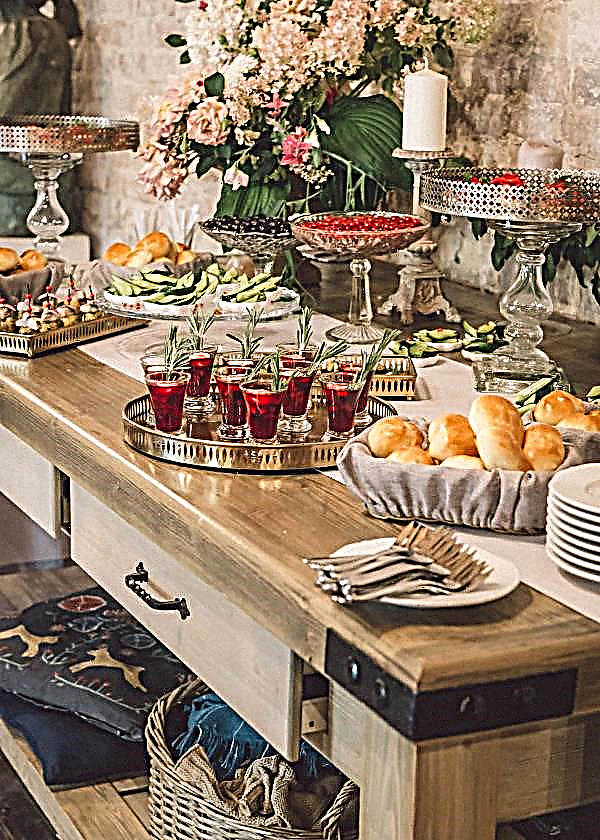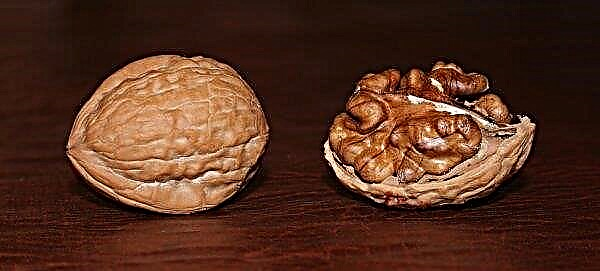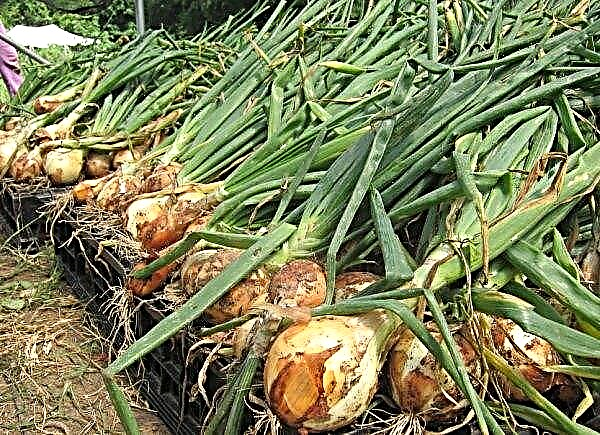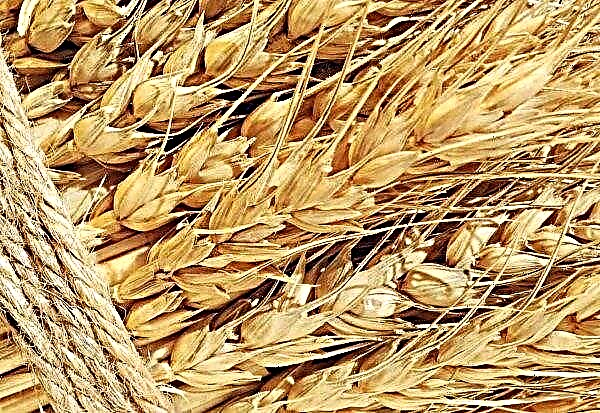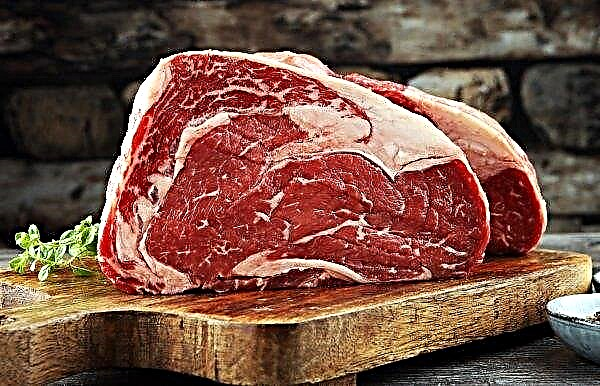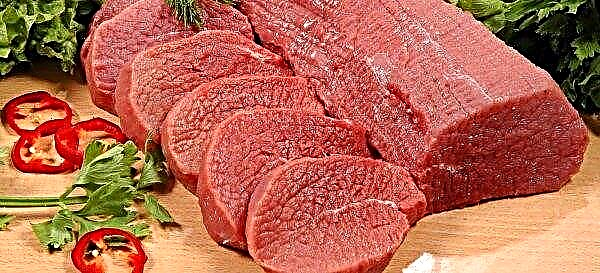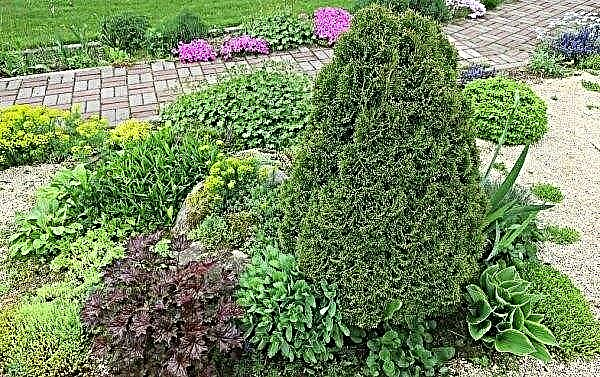Despite the fact that today geranium is not found in our homes as often as before, it is still highly appreciated by gardeners. Her cultivation can not be called a difficult task, but it is worth knowing about some of the nuances of reproduction at home. What constitutes propagation of geranium by cuttings will be discussed in this review.
Brief description of the plant
Geranium (it is also called pelargonium) is a beautiful ornamental plant with a whole range of medicinal properties. This indoor flower with excellent antiseptic ability, it quickly relieves nervous tension and relieves people from stress.
Today, there are more than ten different varietal varieties of geraniums, but all of them can be combined into several groups:
- English (fragrant) pelargonium: characterized by a mint, lemon smell and aroma of a rose, what is their peculiarity;

- balcony (upholstered): have beautiful large flowers with wavy petals up to 6 cm in size; stems - brittle and thick, supplemented by leaf plates with serrated edges;
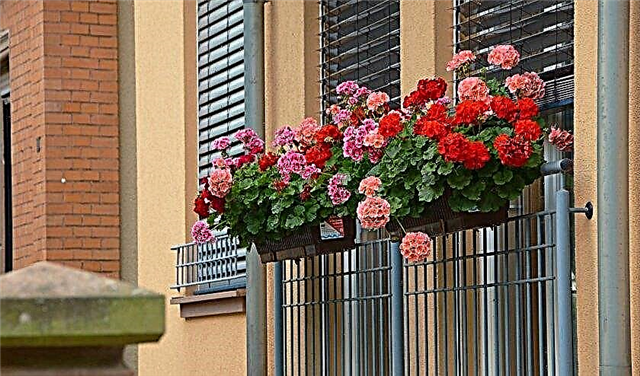
- zonal (or “standing”): with the same thick and brittle stems with rounded leaves and a horseshoe-shaped pattern; simple or double flowers (orange, red, pink or purple shades).
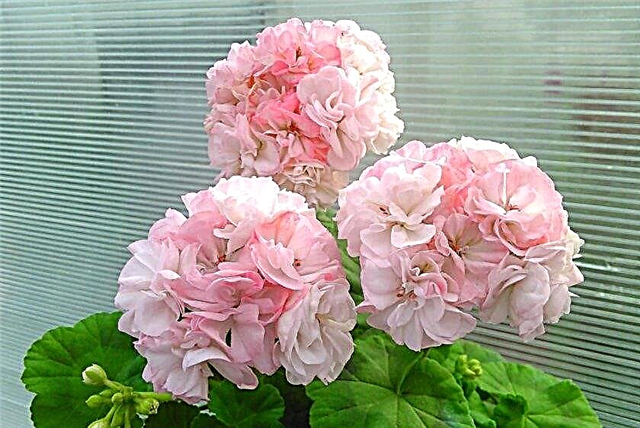
Optimal growing conditions
Some gardeners consider geranium a rather capricious plant, with increased requirements for the conditions of detention. Most varieties are quite mediocre in this regard and can be grown in an ordinary apartment without special care.
Did you know? Geranium has long been considered the protector of the house, and, according to popular beliefs, protects it from any evil. People still say: "Where geranium grows, there is no snake creeping."
The following indicators will be acceptable for the plant:
- Lighting - bright enough, but without direct sunlight. A good solution is to place a pot on the south side of the house, with temporary protection from the sun during its most active period.
- Temperature - not lower than + 12 ºC, and in winter it is advisable to choose the coolest place in the house for the plant, so that in the summer it continues to delight you with lush flowering. Short growth at reduced rates (around + 10 ºC or lower) will contribute to lush flowering in the fall. Geranium is a flower that prefers coolness, but it is impossible to lower the air temperature by spraying from a spray gun or creating drafts.
- Air humidity - within the normal range for the average human home (i.e. approximately 60–75%). However, these values are not an absolute requirement for geraniums - the plant will feel great at lower or slightly higher rates.
- Concerning soil moisture then it’s worth focusing more on the state of the soil, watering the substrate only when the top layer dries.

Preparation of cuttings
Cuttings are not in vain considered the easiest way to get new plants from the mother bush. Compared to sowing seeds, the growing procedure takes much less time. However, in order to get a flower that perfectly resembles a “donor,” you will have to follow certain rules exactly. So, the main condition for the successful propagation of geraniums will be to maintain a stable high temperature and good lighting in a room with seedling pots (and only if all the rules for cutting planting material have been met before).
You can harvest geranium cuttings all year round, but for faster rooting, it is advisable to choose spring time (in autumn, the plant will take longer to take root in a new place). Zonal and coniferous varieties will form roots in two weeks, fragrant ones - not earlier than in six weeks, but this is only subject to their rooting in warm conditions. In the cold season, and especially in winter, these values can be multiplied by two.
Important! In the process of grafting, use a razor blade or a bud knife (the so-called knife for plant grafting). The slice must be accurate, clean, smooth.
The first thing to do when preparing the cuttings is to choose a suitable mother plant and find the appropriate knife (or even a scalpel) with a very sharp blade. When cutting branches in the warm season, when active sap flow occurs inside the plant, it is better to take shoots with a length of at least 10 cm. Cut them exactly in the middle between adjacent leaves. Sliced cuttings should dry out a little, after which they can be treated with absorbent or wood ash. Then the prepared planting material will not become a source of infection and will not rot when moving it to the ground.
At least 2–3 internodes (or the same number of leaflets) should remain on each stalk, but it is advisable to immediately remove the buds and flower arrows so that the plant does not waste energy on them. Soaking geranium cuttings in a growth stimulator is not necessary at all - they can be immediately planted in the soil or rooted in water
Step-by-step instructions for cutting
The process of rooting cuttings in the soil and water has significant differences, therefore, before performing these procedures, it is worthwhile to carefully consider their features.
Landing
When planting geraniums in the soil substrate for each individual cuttings, it is desirable to prepare a separate glass (possibly with a layer of drainage at the bottom). As a soil mixture, you can use the land for flowering plants, purchased in a flower shop. Before this, it is desirable to pour over boiling water or place in the oven in order to get rid of a possible infection.
Did you know? One of the most ancient pottery in the form of a pot belongs to the Tripoli culture.
If there are still no roots on the handle, then it is immersed in the substrate until the first leaf, so that the bottom node with the kidney is under the soil, and another kidney remains above the surface, which will serve as a further growth point. In the presence of roots, it is possible to plant the stem in a glass only after organizing the drainage layer and filling the tank with prepared soil mixture to half the available volume. Then the remaining space is covered with a substrate to close the stalk to the first leaf.
Planted cuttings do not need to be covered with banks or stretch a film over them. The soil in the seedling tank should always remain loose and moderately moist so that the seedling does not rot. The rooting process in the soil lasts an average of 1-2 months. Cuttings of some varieties begin to grow immediately after transferring them to the substrate.
Rooting in water
The rooting of geranium cuttings in water is not possible for all varietal variations, since many specimens immediately begin to rot. To check whether this option is suitable specifically for your case, you can experimentally: after ruining a part of the plant once, this mistake with other cuttings should not be repeated.
The process of rooting in the aquatic environment provides for such further actions:
- Remove the growing leaves from the bottom of the cut stalk.
- Prepare the water: it must be clean and settled, with the addition of 1 tablet of activated carbon in 1 cup of liquid.
- Prepare a container with frosted walls and cut a cardboard cover suitable for it with a central hole for the handle.
- Carefully pass the stem through the opening of the lid and partially immerse it in water to prevent the stem from sagging in the air (all places where roots may appear should be under water).
- Put the container with the handle in a warm and bright place, regularly change the water: at least 1 time in 2-3 days.
Video: rooting geraniums in water
The duration of rooting depends on the individual characteristics of the plant. Rooting in water is not the best way to pelargonium, and in most cases it ends in failure due to high humidity, which the plant does not like.
Care after cuttings for indoor plants
Immediately after planting the shank for some time, it is better to leave it alone so that it grows stronger and adapts to new growth conditions. However, when rooting in the soil mixture and further care for the grown plant, watering, top dressing and pruning cannot be avoided.
Watering and feeding
The rooting of geranium cuttings lasts about 3 weeks, and during this period with watering you need to be very careful. In the first five days after the emergence of the roots, you can not water it, and later, with settled water at room temperature, water the soil only along the edge of the pot, focusing on the level of drying of the substrate.
It is advisable to place freshly transplanted cuttings in the first week in partial shade, and then transfer them to where there is more light so that the leaves do not fade. The same goes for the winter period. If natural light is not enough, you will have to place cuttings and young plants under lighting devices.
Young plants are fed from March to September, using mineral fertilizers for this purpose: first nitrogen-containing (such as Green World or Garden of Miracles), and then phosphorus-potash (Biomaster, Agrekol) for plentiful flowering. They can be applied to the substrate in liquid form, but not earlier than 2-3 weeks after transplanting the cuttings to a constant place of growth. Organic fertilizers for a recently taken shank are not so important. Geraniums and B vitamins (B1, B6 or B12) are suitable, for which one ampoule of a pharmaceutical preparation is diluted in 2 liters of water and water the flower regularly - once every 2 weeks. This will provide lush flowering plants.
Organic fertilizers for a recently taken shank are not so important. Geraniums and B vitamins (B1, B6 or B12) are suitable, for which one ampoule of a pharmaceutical preparation is diluted in 2 liters of water and water the flower regularly - once every 2 weeks. This will provide lush flowering plants.
Trimming and shaping a bush
Pruning of a young plant is carried out in spring, limiting itself to pinching the top of shoots at the initial stages of plant development. This will stop the growth of the handle up, but at the same time will contribute to lateral branching. With this type of reproduction, the line of breaking of the apex will be above 9–10 leaflets. For further cultivation leave only shoots growing from the sinus of the upper pair of leaves. The removed parts do not need to be thrown away, they can also be planted in a pot for germination.
Important! Best plants take root and grow actively if they were transplanted with a growing moon.
Transfer
The parts cut off from the mother bush are best planted in a small container (with further transplantation already after their rooting). Moisture accumulates in an empty substrate (without filling it with plant roots), therefore, until the geranium cuttings form a developed root system, it is better to leave them in a confined space, thereby protecting against root rot. Depending on the variety and variety of pelargonium, the rooting process takes from two to six weeks, and a clear sign of a successful procedure will be the appearance of new green leaves on the handle.
Later, the plant can be transplanted into a permanent pot, carefully handling the seedling in a new container. The signal for transplanting the grown geranium will be the germination of the rhizome through the drain holes. Usually they appear from there no earlier than in 2-3 years. For each transplant, it is advisable to choose a container only 2-3 cm larger than the previous one. The reason is that the substrate should not be empty.
Video: geranium transplant
Pest and Disease Control
The most common diseases of geraniums include root rot and root rot of a plant’s neck (when the roots are covered with brown or black coating, and the stem softens and can no longer hold the plant in an upright position). To save young seedlings is unlikely to succeed.
An equally common flower disease is gray mold manifested by clusters of gray fluffy plaque on individual parts of the plant. To limit the rate of spread of this disease, it is useful to take the plant to the sunny side and treat it with antifungal drugs, for example, "Fundazole" or "Vitaros".
Did you know? Many years ago, Leonardo da Vinci came up with a rule that states: the square of the diameter of the barrel is equal to the sum of the squares of all diameters of the grids that are located at the same height. Modern scientists have confirmed this fact.
Of the pests of pelargonium, they are especially active in aphids, spider mites, whiteflies and nematodes (they destroy the root system of geranium, which manifests itself in the form of peculiar nodes with pathogens contained inside). The last ailment will not be able to cope, and the plant will have to be thrown away.
Regularly check the condition of the plant in order to identify possible defects in time. Black dots and small spots on the leaves may indicate the presence of a disease, with timely treatment of which the plant will be able to save. In other cases, you can try to wash the leaves of geraniums and treat them with special insecticides (“Messenger”, “Marathon”, “Monterey”). As folk remedies for pest control, a solution of aspirin (1 tablet per 8 liters of water) is used, with which the affected leaves are sprayed once every 3 weeks.
In other cases, you can try to wash the leaves of geraniums and treat them with special insecticides (“Messenger”, “Marathon”, “Monterey”). As folk remedies for pest control, a solution of aspirin (1 tablet per 8 liters of water) is used, with which the affected leaves are sprayed once every 3 weeks.
Useful Tips
Cuttings of pelargonium are a good way of propagating it.
In order to achieve the most effective result from growing cuttings, it is important to remember a few simple recommendations regarding this process:
- Cuttings can be cut both in winter and summer, but the end of February – beginning of March is considered the ideal time for such a procedure. It is precisely at this period that the active growth of geranium falls, which means that all processes inside it will take place at an increased speed.
- For rooting, parts of apical shoots, not less than 10 cm long, are best suited. On the resulting segment should be located at least four healthy leaves of 7 cm each.
- As a cutting tool, you can use only a sharp disinfected knife or a scalpel, which will prevent the possibility of infection of the mother plant.
- As a donor flower, it is advisable to use only healthy adult specimens, whose age is at least 2 years.
- The sections planted for rooting are first covered with a film, and after its removal (about 5 days), a box with seedlings is placed in a well-lit place (with daylight hours within 12-14 hours).
- The ideal temperature for the formation of the root system of cuttings is + 18 ... + 24 ºC.
- When planting several cuttings in the mother liquor at once, a distance of at least 3 cm should remain between them.
The process of cutting Pelargonium in any case will not take much time, and following these simple recommendations, the plant will please you with a riot of colors in a few months. Propagating the plant by cuttings, you will not want to deal with seeds (at least when growing geraniums), since this is not such a time-consuming process.





